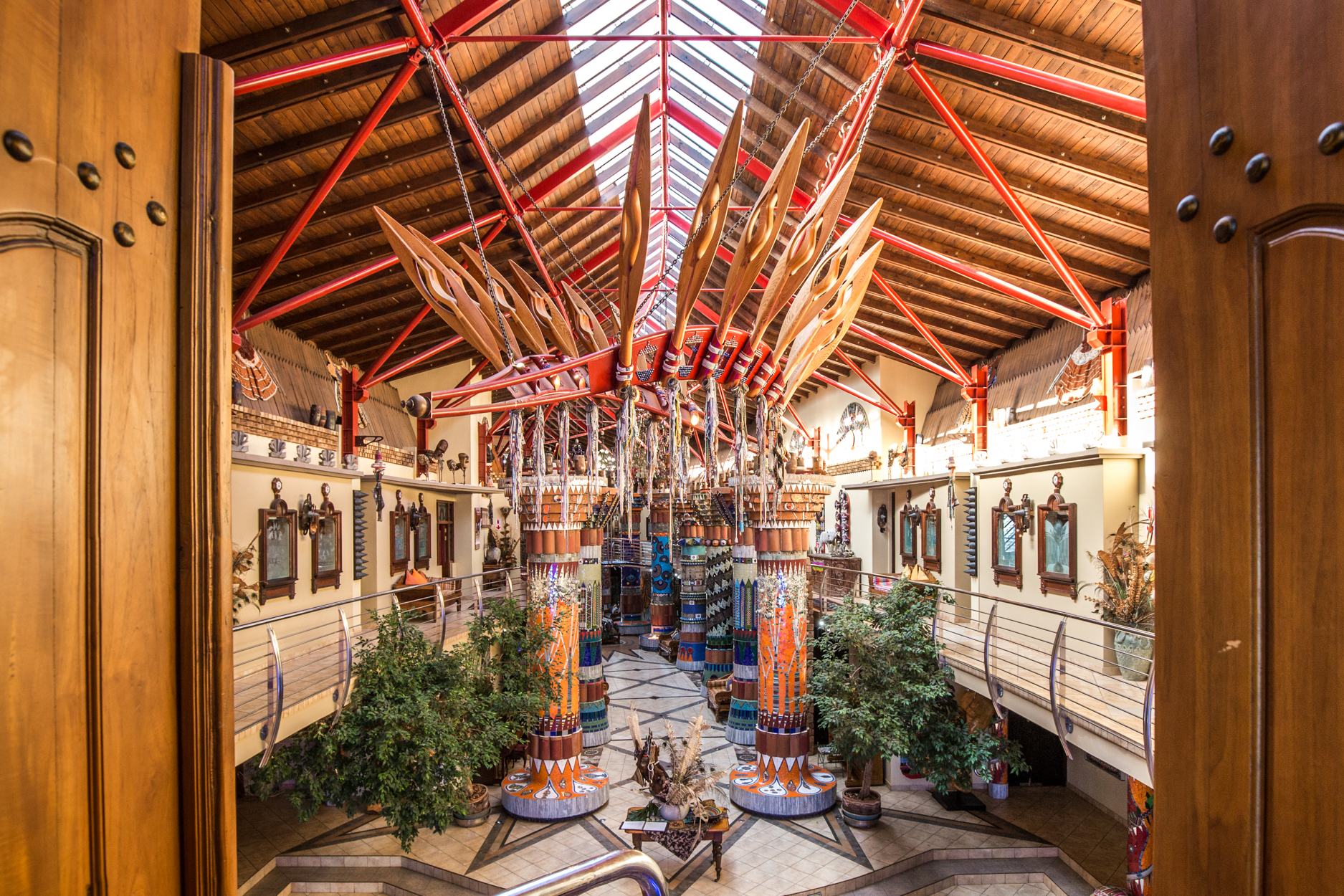It took several decades to transform the dream and vision of artist and architect Peter Amm into a reality. The dream came to Peter in the year 2000, after owning land bordering the Kranzkloof Nature Reserve for nearly 40 years. Approaching architect and friend Kevin MacGarry, they together designed this architectural marvel, perched on a hill in Kwa-Zulu Natal – Ammazulu African Palace.
Amazulu refers to the Zulu people, or as an adjective, ‘pertaining to the Zulu people, or their culture or traditions’. Add Peter’s surname to that, and you get Ammazulu. The property is now a boutique hotel dubbed the African Palace, providing a sensory experience like no other.
From above, you’ll see the curved building follows the kidney shape of the property, a solution to maximize space and develop the magnificent building Peter envisioned. “The contractors won a Master Builders award for the construction, because back then it was one of the first of its kind. They explained it as a three-dimensional roof on a two-dimensional frame. And the curvature made it even more technical,” explains Manager Alta du Plooy.
Traveling along the winding driveway, surrounded by indigenous forest, you would never expect the explosion of color and life at the entrance as you turn the corner. Your eye is immediately drawn to two massive mosaiced pillars, bordered by even larger rock pillars that create a grand palace feel. These pillars are repeated throughout the interior of the building, designed by artist Jane du Rand. The closer you look at each one, the more you’ll see: teaspoons and mugs, tennis balls, plant pots, contributing to the overall picture.
That’s a trend that continues throughout the building, not just in the pillars themselves. The walls of the palace, including each of the rooms, are covered with artworks created by Peter. Most are recycled and nothing is allowed to go to waste, from the beadwork collages to the light fixtures made from decorated garden rakes. “The chandeliers have been made by the metal rebars that originally kept the building together. But he’s taken it a step further by adding all his childhood toys. I can imagine him walking down this memory lane, imagining his childhood and realizing he had a dream and made it a reality.”
Much of the traditional beadwork and artifacts were collected by or gifted to Peter over the years, displayed in the palace as a homage to Zulu culture. Downstairs, traditional rickshaws fill the right corner, along with life-size sculptures. Open shelves upstairs display a range of beaded waistcoats, headrests, hats, and other cultural artifacts like earplugs (also the logo of the hotel). The bowls used on the walls display motifs that each have unique meaning, creating an entire story in a single beaded display. “Beadwork is a form of communication. There’s poetry in it.”
While most of these artifacts are on display, allowing guests to get up close and personal, there are a few special items kept behind the ‘peeping window’ as you come through the entrance. Here, you’ll find a collection of African dolls, traditional Zulu attire, and even a vintage Louis Vuitton beaded handbag. Each item has a story, collected over years and years and placed in this museum-like room for preservation.
The building features art in all forms from a range of South African artists. Four large canvases line the building, created by graffiti artist Gogga, inspired by Jane’s pillars. Sculptures by Carl Roberts fill the lounge area upstairs in various mediums, while the downstairs seating area features a baobab sculpture by Gert Swart weighing over five tonnes. Four panels by Margaret Ruxton are hung outside the rooms upstairs, along with glass etchings by Jean Powell, mounted in antique Stations of the Cross rescued from St Mary’s Mission in Durban.
Other artworks, and much of the furniture in the rooms, were imported from abroad. Peter collected items from his travels, particularly Southeast Asia, bringing items like cabinets, benches, and even the ornate doors on the second floor to the palace. An antique Indian elephant door dating back to 1690 has been restored, used by guests to enter the main walkway. One of the most complex pieces, a massive teak panel was brought in from Thailand in 2016, carved by one man over 10 years.
“Unfortunately, it’s the type of place where you can’t just spend an hour. You need to spend a day to sit, and walk, and observe.” According to Alta, what visitors appreciate most beyond the visual spectacle is the ability to get away, and to think. “People come here to dream, to write books. We have people that come and write songs and poetry. They just sit.”

This article was published in the April 2024 issue of Garden&Home.

